 1979-018A 25 February 1979
1979-018A 25 February 1979
Pad 31, Site 6, Baikonur Cosmodrome, Kazakhstan 19 August 1979 (aboard Soyuz 34)
211 km southeast of Dzhezkazgan R7 (11A511U); spacecraft serial number (7K-T) #48 175 days 0hrs 37min 37 sec Proton (Proton)
Third Salyut 6 resident crew programme
Flight Crew
LYAKHOV, Vladimir Afanasevich, 37, Soviet Air Force, commander RYUMIN, Valery Viktorovich, 39, civilian, flight engineer, 2nd mission Previous mission: Soyuz 25 (1977)
Flight Log
The original plan for Salyut 6 was to include three long-duration missions, by Soyuz 25, 26 and 28, with visits by Soyuz 27, 29 and 30. The Soyuz 25 failure resulted in a reschedule and at first an anticipated reduction from three to two long-duration missions. By February 1979, however, Salyut’s condition was assessed to be worth a try at the third long-duration mission, by Soyuz 32, during which two further international missions would also be attempted. Soyuz 32, crewed by veteran Valery Ryumin and rookie commander Vladimir Lyakhov, took off in extremely overcast and murky skies at 16: 54 hrs local time. Their record residency aboard Salyut 6, which they entered the following day, was destined to be a long, lonely one.
The crew immediately checked over the station and found it in good condition, apart from the confirmation that there was a potentially serious problem with the station’s fuel system. A membrane in a liquid fuel and gaseous nitrogen gas line had warped. Orders were given to launch Progress 5 to start the restocking process. This arrived on 12 March, carrying, among other things, a TV monitor to permit the first two-way visual communications with the ground and an improved Kristall furnace. Before Progress 5 started refuelling, the tank connected to the line which had warped was ingeniously emptied by spinning the space station. This fuel was then transferred into another tank.
Each day, the crew embarked on a strenuous two-and-a-half-hour period of exercise to ward off the ill-effects of weightlessness which would be felt on landing back in 1-G. They took the first Soviet shower in space and by the end of March had completed nearly 40 repairs on the station, as well as their scientific work. All was ready for the arrival of Soyuz 33 with a Bulgarian visitor on 11 April. When this
|
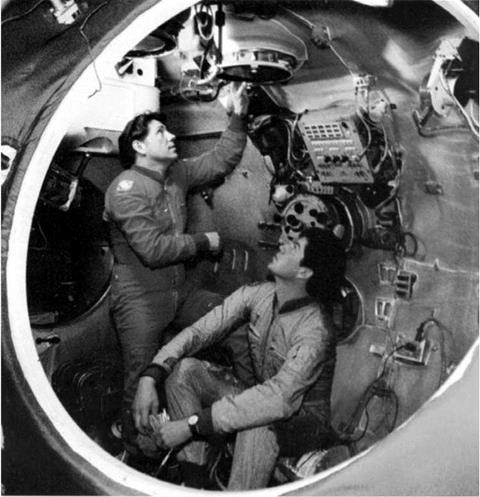
Lyakhov and Ryumin in the transfer compartment of the Salyut 6 1-G trainer at TsPK.
|
mission failed to dock and had to make an emergency return to Earth, the following Hungarian mission, too, was cancelled, and the resident crew, which reached a maximum altitude of 406 km (252 miles) in the 51.6° orbit, resigned themselves to unmanned visits by further Progress tankers. The sixth of these arrived on 13 May.
An unusual step was then taken to ensure that Lyakhov and Ryumin had a fresh ferry vehicle. Soyuz 32 was replaced by Soyuz 34 (1979-049A), which was launched unmanned on 6 June. This docked at the rear and after Soyuz 32 returned unmanned, the crew took Soyuz 34 from the back to the front, in preparation for the arrival of Progress 7. Launched on 28 June, this new tanker delivered a radio telescope called the KRT-10, designed to monitor pulsars and other celestial phenomena. It was pushed through the aft docking port before Progress departed, and as the tanker undocked was automatically unfurled to a diameter of 10 m (33 ft), a record for a space dish antenna.
It may have jammed against some of the station’s appendages and not have unfurled correctly however, because after work with the KRT-10, the mission was thrown into a frenzy when the cosmonauts could not discard it in order to clear the aft docking port for another possible Progress launch to replenish the station later. Thanks to the intensive repair work by the cosmonauts, the station was being considered for several more missions, rather than being de-orbited. Therefore, Ryumin, assisted by Lyakhov, made an unscheduled and highly risky spacewalk on 15 August, reminiscent of the Skylab 2 EVA in 1973, to free the KRT using wire cutters. Their 1 hour 23 minute effort was successful.
The crew became the first to land in a spacecraft, Soyuz 34, that had been launched unmanned, at T + 175 days 0 hours 37 minutes 37 seconds, 211km (131 miles) south east of Dzhezkazgan. They had to be carried from the capsule and placed in reclining chairs. Although recovered fit and well after four days, Lyakhov and Ryumin at first had difficulty speaking properly and felt the effects of re-adaptation quite starkly; blankets felt like chainmail and beds like boards, they said.
Milestones
70th manned space flight
39th Soviet manned space flight
31st Soyuz manned space flight (Soyuz 32 up only)
33rd Soyuz manned space flight (Soyuz 34 down only)
New duration record – 175 days 0 hours
1st manned space flight to land in spacecraft launched unmanned 5th Soviet and 20th flight with EVA operations Lyakhov celebrates 39th birthday in space (28 Jul)
Ryumin celebrates 40th birthday in space (16 Aug)

Flight Crew
RUKAVISHNIKOV, Nikolay Nikolayevich, 46, civilian, commander, 3rd mission
Previous missions: Soyuz 10 (1971); Soyuz 16 (1974)
IVANOV, Georgy Ivan, 38, Bulgarian Air Force, cosmonaut researcher
Flight Log
Conditions at the Baikonur Cosmodrome at 22: 34 hrs local time on 10 April were described as the worst ever for a Soviet launch, as the SL-4 booster was committed to lift-off in winds of 40 kph (25 mph). Another international mission was under way, this time with the moustached Bulgarian Georgy Ivanov alongside the first Soviet civilian commander, Nikolay Rukavishnikov, who also happened to be the first non-pilot to command a spacecraft.
Soyuz 33 began its orbital manoeuvres for the rendezvous with Salyut 6, reaching a maximum altitude of 261 km (162 miles) at 51.6°, but Rukavishnikov was not happy with the main propulsion system. Instinctively, he knew that something was not quite right and this was confirmed on the control panel, with readings indicating lower chamber pressures than normal. One of the final manoeuvres for the rendezvous was a 6-second burst of the main engine, which fired erratically for 3 seconds and then shut down. The docking was off. The fault was later traced to the gas generator feeding the turbo-pump in the spacecraft’s main engine.
While the failure and routine return to Earth of the powerless Soyuz ferry were reported matter-of-factly by the Soviet news agencies, controllers and cosmonauts were very worried about the Soyuz 33 crew’s safety. The back-up propulsion unit would have to be used for the retro-burn and had never been used before on a manned mission. In addition, it was only capable of one continuous burn, rather than a two – phase retro-burn normally used to induce a stress-reduced, 3-G lifting re-entry. The ballistic re-entry would therefore involve much higher g-forces. The nominal back-up engine burn time was 188 seconds, but there was no guarantee that it would perform as
|
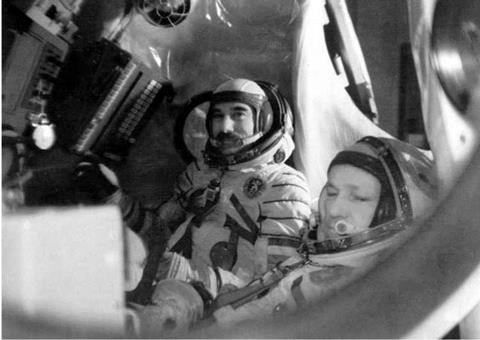
The Bulgarian Interkosmos crew during training, with Ivanov seated behind commander Rukavishnikov
|
advertised. There was a facility to allow the crew to start it manually if it cut off after burning for at least 90 seconds, but even so, the re-entry would be extremely inaccurate.
Anything shorter would have meant them being stranded in orbit. A longer burn than nominal could place an intolerable G-force on the spacecraft and crew. Ivanov was told to make sure he tucked his moustache inside his helmet! Soyuz 33’s back-up engine fired for 213 seconds which was longer than normal and Rukavishnikov had to manually shut it down. For 530 seconds, the crew was subjected to G-forces between 10-G and a peak of 15-G. Rukavishnikov later commented that as the Soyuz DM descended it was like being inside the flames of a blowtorch. Externally, temperatures reached 3,000°C and the crew experienced a lot of vibration and noise. Pinned to their seats by the G forces, both reported difficulty in breathing but were still able to talk to each other. The capsule was glowing red as it landed beneath darkening skies 318 km (198 miles) southeast of Dzhezkazgan at T + 1 day 23 hours 1 minute 6 seconds.
Unlike NASA, there are no copies of the post-flight reports of the Soviet accident investigation boards publicly available. Accounts of what happened are left to personal recollections, sometimes years after the event, making for conflicting accounts of the facts. The official RKK Energiya history and the memoirs of Flight Director Alexei Yeliseyev record that the engine failed to provide enough thrust and the deceleration impulse was less than planned. Soviet space analyst and historian Bart Hendrickx has suggested that perhaps the automatic systems on the Soyuz tried to compensate for the inadequate firing of the engine by commanding a longer burn than planned and the crew, unaware of this, simply shut it down. Landing close to the planned recovery site was pure coincidence according to Yeliseyev. Due to the insufficient deceleration, Soyuz 33 took longer to enter the atmosphere, but as a result of the longer engine burn, a steeper angle compensated for the increase descent time.
Milestones
71st manned space flight
40th Soviet manned space flight
32nd Soyuz manned space flight
1st manned space flight commanded by non-pilot
1st civilian engineer-cosmonaut to command a Soviet mission
1st manned space flight by a Bulgarian
4th Interkosmos mission

Flight Crew
POPOV, Leonid Ivanovich, 34, Soviet Air Force, commander RYUMIN, Valery Viktorovich, 40, civilian, flight engineer, 3rd mission Previous missions: Soyuz 25 (1977); Soyuz 32 (1979)
Flight Log
Assigned to this next long-duration mission to Salyut 6 were commander Leonid Popov and flight engineer Valentin Lebedev, who injured his knee shortly before liftoff while exercising on a trampoline. Mission officials decided to adhere to the new rule that at least one flight experienced crewman should fly a mission and chose a certain Valery Ryumin as Lebedev’s replacement. So, eight months after coming home from the Soyuz 32 marathon, the tall, burly Ryumin was off again. Soyuz 35 lifted off into a decidedly murky sky at 19: 38 hrs local time on 9 April. Within 26 hours, Soyuz 35 was safely nestled at Salyut 6 and Ryumin entered the station to read a welcoming letter written by himself before he last left. Before Soyuz 35 had arrived, Salyut 6 had received two visits from unmanned spacecraft; the new Soyuz T1 ferry vehicle on an automatic test and a regular tanker visit from Progress 8, which was used to boost Salyut’s orbit and was there ready for unloading when the cosmonauts arrived. The rookie Popov went about his work in such a frenzy of enthusiasm that the experienced Ryumin told him to slow down – they were going to be there for a while.
After unloading Progress 8, the cosmonauts discarded it and almost immediately received Progress 9 in order to take on more equipment, including a new motor for a biogravity centrifuge. Progress 9 was also used for the first time to unload water into Salyut 6. Ryumin keenly tended his Oasis space garden and proudly displayed one of its products, a huge cucumber, which he later revealed was a plastic one.
The cosmonauts played host to several visiting crews and also unloaded two more Progress tankers. Soyuz 36 arrived with a Hungarian cosmonaut researcher in May, two Soviet cosmonauts arrived in Soyuz T2 in June, Progress 10 arrived the same month, and Soyuz 37 in July, with a crew including a cosmonaut researcher from
|
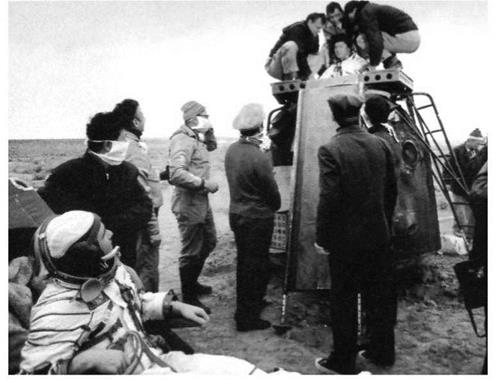
Popov (seated) watches rescue teams remove Ryumin from the DM of Soyuz 35 at the end of the 185-day mission.
|
Vietnam. A Cuban followed in Soyuz 38 during September, and finally that month Progress 11 arrived and stayed docked for a record 70 days, well after Popov and Ryumin had returned to Earth. These regular visits meant that the resident crew estimated that they spent 25 per cent of their time in Salyut unloading equipment and cosmonauts. One major exercise during a hiatus in the visits during August was a dedicated period of Earth resources photography of targets in the Soviet Union, using the MKF-6M and KT-140 cameras. The approximately 4,500 images covered a total of 96 million km2 (37,056,000 miles2).
During the mission Ryumin put on 3.1 kg (7 lb), which was an unusual statistic for a space traveller. He and Popov had reached 365 km (227 miles) maximum altitude during the 51.6° orbit. They boarded the fresh Soyuz 37 and came home 180 km (112 miles) southeast of Dzhezkazgan at T + 184 days 20 hours 11 minutes 35 seconds, remarkably fresh and fit after a new record duration mission, which was not officially recognised as such by the IAF since it only exceeded the previous mission by nine days, not the required ten per cent. Nonetheless, Ryumin, with three flights under his belt, had clocked up almost a year’s space experience, and declared that he was ready to fly to Mars.
Milestones
72nd manned space flight 41st Soviet manned space flight 34th manned Soyuz space flight
Ryumin celebrates his 41st birthday in space (16 August)
1st person to celebrate two consecutive birthdays in space (Ryumin) Popov celebrates his 35th birthday in space (31 August)
1980-041A 26 May 1980
 Pad 31, Site 6, Baikonur Cosmodrome, Kazakhstan 3 June 1980 (in Soyuz 35)
Pad 31, Site 6, Baikonur Cosmodrome, Kazakhstan 3 June 1980 (in Soyuz 35)
140 km southeast of Dzhezkazgan R7 (11A511U); spacecraft serial number (7K-T) #52 7 days 20 hrs 45 min 44 sec Orion (Orion)
Hungarian Interkosmos visiting mission programme; Soyuz ferry exchange mission
Flight Crew
KUBASOV, Valery Nikolayevich, 45, civilian, commander, 3rd mission Previous missions: Soyuz 6 (1969); Soyuz 19 ASTP (1975)
FARKAS, Bertalan, 30, Hungarian Air Force, cosmonaut researcher
Flight Log
Regarded with much hullabaloo in Hungary but not elsewhere, Soyuz 36, delayed from June 1979, lifted off from Baikonur at 00: 21 hrs local time on 27 May, carrying cosmonaut researcher Bertalan Farkas and his Soviet commander Valery Kubasov. Farkas arrived inside Salyut 6 bearing succulent gifts of goulash, pate de foie gras, fried pork and jellied tongue, and soon got down to work with his national experiments called Daignost, Balaton, Interferon, Dose, Opros, Andio, Oxymeter, Biosphere, Refraction, Zarya, Bealuca, Eotvos and Ilkeminator.
Farkas, who adapted to weightlessness much faster than his flight experienced colleague Kubasov, helped to process gallium arsenide crystals with chromium, assessed the misalignment of instruments due to long exposure to the space environment, made a photographic geomorphological map of the Carpathian Basin, studied hearing and human motor response in weightlessness and attempted to study the behaviour of the cancer fighting drug Interferon in weightlessness. The Interferon experiment was divided into three separate studies: to assess the effect of weightlessness in Interferon production in the lymphatic system on the human body, study changes in Interferon samples in weightlessness, and assess the effect of Interferon on blood samples taken before launch and after landing.
The mission, which reached 355 km (221 miles) in the 51.6° orbit, ended with a night landing at T + 7 days 20 hours 45 minutes 44 seconds in Soyuz 35, 140 km (87 miles) southeast of Dzhezkazgan. The fresher Soyuz 36 was left for the resident crew in case of the need for an emergency return.
Milestones
73rd manned space flight
42nd Soviet manned space flight
35th Soyuz manned space flight
1st manned space flight by a Hungarian
5th Interkosmos mission
1980-045A 5 June 1980
 Pad 1, Site 5, Baikonur Cosmodrome, Kazakhstan 9 June 1980
Pad 1, Site 5, Baikonur Cosmodrome, Kazakhstan 9 June 1980
198 km from Dzhezkazgan
R7 (11A511U); spacecraft serial number: (7K-ST) #07L 3 days 22hrs 19 min 30 sec Yupiter (Jupiter)
Manned test flight of new Soyuz T ferry
Flight Crew
MALYSHEV, Yuri Vasilyevich, 38, Soviet Air Force, commander AKSENOV, Vladimir Viktorovich, 45, civilian, flight engineer, 2nd mission Previous mission: Soyuz 22 (1976)
Flight Log
After the unmanned Soyuz T1 test flight in 1979, the cautious Soviets decided to test the new vehicle again on a short mission with a crew aboard. Wearing new style space – suits, Yuri Malyshev and Vladimir Aksenov lifted off from Baikonur at 20: 19hrs local time, heading for a totally automatic rendezvous and docking with Salyut 6. The hands-off docking became a hands-on one from 210 m (689 ft) because the avionics aboard the new ship failed. Malyshev and Aksenov, who reached a maximum altitude of 349 km (217 miles) at 51.6°, spent a brief time with Salyut 6 hosts Ryumin and Popov before heading home, departing the station 2 days 17 hours 22 minutes after docking.
En route, they jettisoned the Orbital Module before rather than after retro-fire to save fuel and, according to some western analysts, possibly to demonstrate that an Orbital Module could be left attached to Salyut to act as a special laboratory. Soyuz T2 came home at T + 3 days 22 hours 19 minutes 30 seconds, 198 km (123 miles) from Dzhezkazgan, with black soot covering its windows after the fiery re-entry and with the aid of larger deceleration rockets to aid touchdown.
Milestones
74th manned space flight 43rd Soviet manned space flight 36th Soyuz manned space flight 1st Soyuz T manned space flight
|
A successful test flight. Soyuz T2 cosmonauts Aksyonov (left) and Malyshev back on Earth after evaluating the capabilities of the improved Soyuz ferry vehicle.
|
|
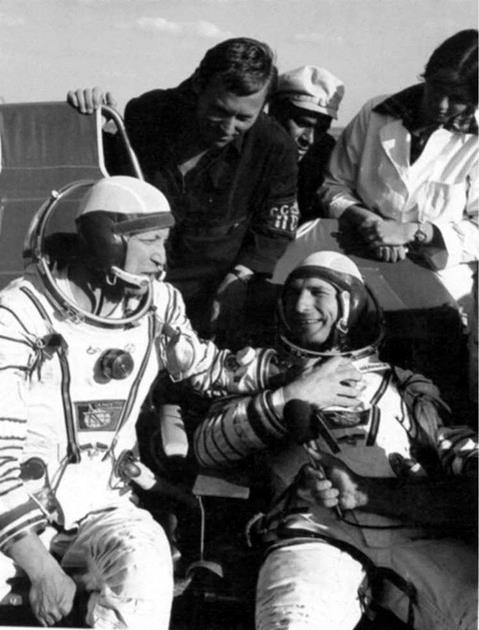
 1980-064A 23 July 1980
1980-064A 23 July 1980
Pad 1, Site 5, Baikonur Cosmodrome, Kazakhstan 31 July 1980 (in Soyuz 36)
179 km southeast of Dzhezkazgan R7 (11A511U); spacecraft serial number (7K-T) #53 7 days 20 hrs 42 min Terek (Terek)
Vietnamese Interkosmos visiting mission programme; Soyuz ferry exchange mission
Flight Crew
GORBATKO, Viktor Vasilyevich, 45, Soviet Air Force, commander, 3rd mission
Previous missions: Soyuz 7 (1969); Soyuz 24 (1977)
TUAN, Pham, 33, Vietnamese Air Force, cosmonaut researcher
Flight Log
The Interkosmos international manned missions to Salyut 6 were accompanied by much propaganda, most of which rubbed up many western observers the wrong way. This was particularly true for the flight of Soyuz 37 with cosmonaut researcher Pham Tuan, hailed as the only pilot to have shot down an American B-52 during the Vietnam War, a claim refuted by the USA. One of his tasks during the flight, according to the Soviets, was to study the effects on the Vietnamese countryside, plants and forests of the enormous amounts of defoliants and fire bombs dropped during the conflict.
Western sports journalists reporting from the Moscow Olympics – much boycotted as a result of the Soviet invasion of Afghanistan – were told to applaud when told of the launch, which was the usual spectacular event, since it again took place at night, 00: 33hrs local time at Baikonur. Twenty-six hours later, Tuan and his commander Viktor Gorbatko had docked with Salyut 6 to give more company to the residents, Ryumin and Popov.
Tuan’s adaptation to weightlessness was rather uncomfortable as he suffered a headache and loss of appetite, but he soon picked up to start his busy schedule of highly scientific tasks, such as taking photos of Vietnam with the MKF-6M camera to reveal details of tidal flooding, silting at river mouths and other hydrological features. The flight ended with a landing in Soyuz 36, at T + 7 days 20 hours 42 minutes, some 179 km (111 miles) southeast of Dzhezkazgan. Maximum altitude reached during the 51.6° mission was 351km (218 miles).
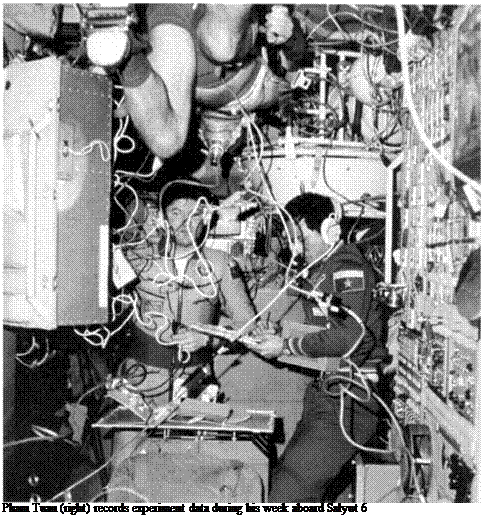
Milestones
75th manned space flight
44th Soviet manned space flight
37th Soyuz manned space flight
36th (original) Soyuz manned space flight
1st manned space flight by a Vietnamese
6th Interkosmos mission
1980-075A 18 September 1980
 Pad 1, Site 5, Baikonur Cosmodrome, Kazakhstan
Pad 1, Site 5, Baikonur Cosmodrome, Kazakhstan
26 September 1980
17 km southeast of Dzhezkazgan
R7 (11A511U); spacecraft serial number (7K-T) #54
7 days 20 hrs 43 min 24 sec
Tamyr (Tamyr)
Cuban Interkosmos visiting mission programme
Flight Crew
ROMANENKO, Yuri Viktorovich, 36, Soviet Air Force, commander,
2nd mission
Previous mission: Soyuz 26 (1977)
TAMAYO-MENDEZ, Arnaldo, 38, Cuban Air Force, cosmonaut researcher
Flight Log
Even the most enthusiastic space watcher, except the few in Cuba, would have found the latest Interkosmos mission little more than a monotonous repeat of those that had gone before. Cuban Arnaldo Tamayo-Mendez studied the crystallisation of sucrose in weightlessness for the benefit of his country’s sugar industry on his Soyuz 38 mission, with commander Yuri Romanenko. This began at 01: 11 hrs local time at the Baikonur Cosmodrome and, as usual, 26 hours later, Soyuz 38 homed in on Salyut 6 with its occupants Ryumin and Popov.
Other experiments being conducted by Mendez included one in which he wore heavy overshoes, to assess ways of preventing muscular deterioration in space. One unique point about the mission, apart from its Cuban connection, was that at its end it touched down within 2.9 km (2 miles) of the predicted landing point in the most accurate landing in the Soviet space programme to date. Flight time was 7 days 20 hours 43 minutes 24 seconds and the mission achieved a maximum altitude of 350 km (217 miles) in the 51.6° orbit.
Milestones
76th manned space flight 45th Soviet manned space flight 38th Soyuz manned space flight
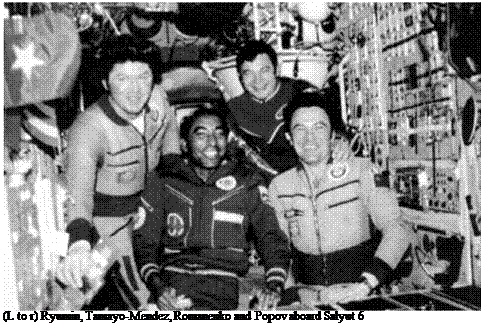
37th (original) Soyuz manned space flight 1st manned space flight by a Cuban 7th Interkosmos mission
1980-094A 27 November 1980
 Pad 1, Site 5, Baikonur Cosmodrome, Kazakhstan
Pad 1, Site 5, Baikonur Cosmodrome, Kazakhstan
10 December 1980
129 km southeast of Dzhezkazgan
R7 (11A511U); spacecraft serial number #08L
12 days 19hrs 7 min 42 sec
Mayak (Lighthouse)
Salyut 6 maintenance mission; Soyuz T three-crew test flight
Flight Crew
KIZIM, Leonid Denisovich, 39, Soviet Air Force, commander MAKAROV, Oleg Grigoryevich, 47, civilian, flight engineer, 4th mission Previous missions: Soyuz 12 (1973); Soyuz 18-1 (1975); Soyuz 27 (1978) STREKALOV, Gennady Mikhailovich, 40, civilian, research engineer
Flight Log
The first three-crew Soviet manned space flight since the Soyuz 11 disaster of 1971, Soyuz T3 was also the first maintenance mission, designed to overhaul the aging Salyut 6 space station to prolong its already long life sufficiently to accommodate a further three missions, two of which were international flights. Lift-off came at 19: 18hrs local time at Baikonur, carrying rookie commander Leonid Kizim and research engineer Gennady Strekalov, along with the first Soviet space four-timer, Oleg Makarov. Unlike Soyuz T2, this flight made a totally automatic docking with Salyut 6 and a hectic two-week repair mission began.
In addition to the busy schedule of repairs, the crew did conduct two science experiments; to study the behaviour of crystals in weightlessness, extensively using the onboard furnaces; and the use of a laser-based holographic system to photograph the dissolution of a salt crystal. Kizim and his colleagues overhauled the hydraulic system on board Salyut, installing a new hydraulic unit and pumps. They also replaced a programming device in the control system, fitted a new transducer to a compressor in the in-orbit refuelling system, and replaced electronic components in the communications system.
While the crew was still on board, the Progress 11 tanker’s main propulsion system was fired to raise the station’s orbit. The tanker was then discarded, followed by the crew’s entry into Soyuz T3 and an automatic retro-fire and re-entry to a landing at T + 12 days 19 hours 7 minutes 42 seconds, 129 km (80 miles) southeast of Dzhezkazgan. Maximum altitude achieved during the 51.6° mission was 398 km (247 miles). Salyut was ready for another long-duration visit and in preparation
|
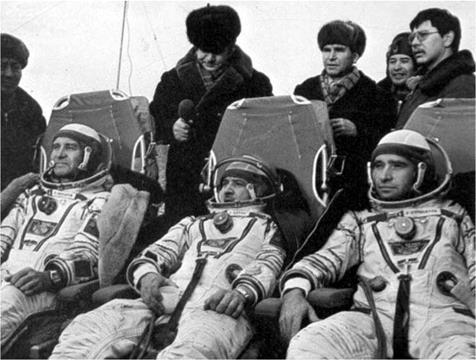
The safe recovery of the Soyuz T3 crew, the first three-person Soviet space crew since 1971. L to r: Makarov, Kizim, Strekalov
|
for it, another Progress was dispatched from Baikonur, to await a new crew. With Soyuz T3 featuring a three-person crew, it proved the greater flexibility of the new spacecraft and opened up the possibility of crewing a Salyut with three residents instead of two, offering greater productivity. However, the Soviets had revealed that on future Soyuz T missions, the crew composition would vary and would not always include a cosmonaut researcher (who had no piloting functions) in the third seat. On occasion, the third seat would be occupied by additional supplies or science experiments.
Milestones
77th manned space flight
46th Soviet manned space flight
39th Soyuz manned space flight
2nd Soyuz manned space flight
1st Soviet three-person crew since 1971











 1962 tau 1 24 May 1962
1962 tau 1 24 May 1962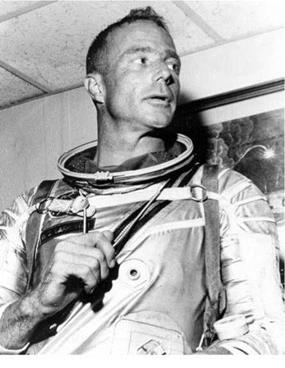


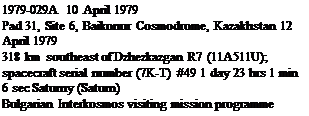


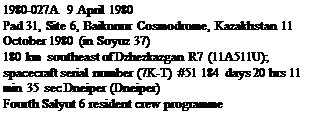

 Pad 31, Site 6, Baikonur Cosmodrome, Kazakhstan 3 June 1980 (in Soyuz 35)
Pad 31, Site 6, Baikonur Cosmodrome, Kazakhstan 3 June 1980 (in Soyuz 35)






